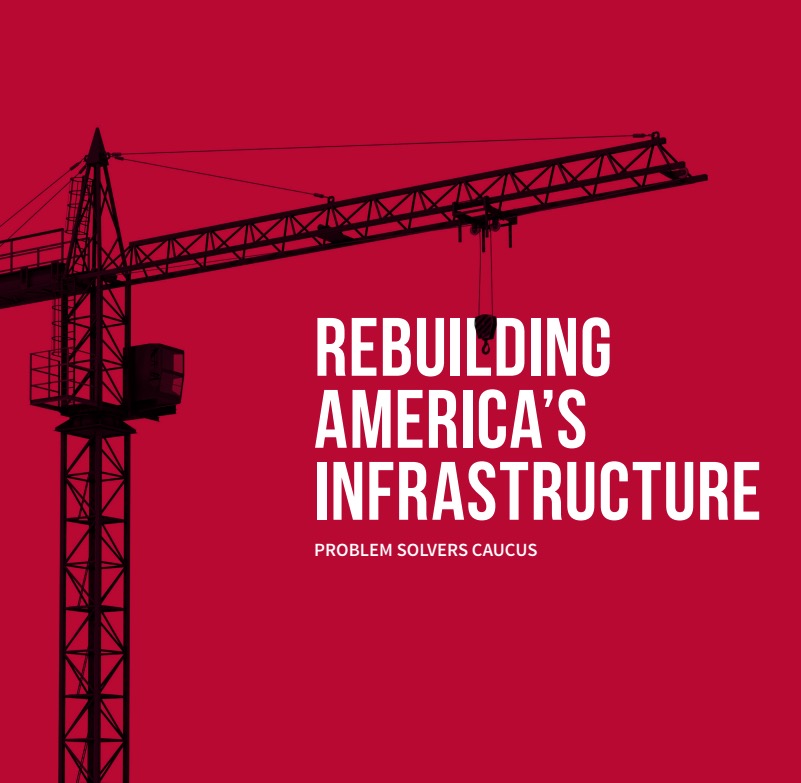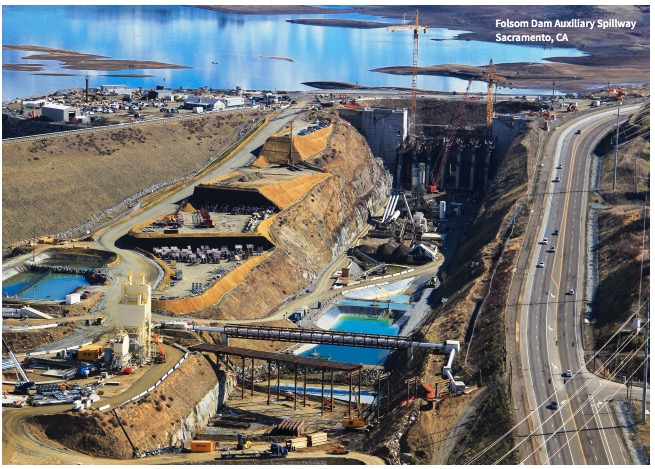PROBLEM SOLVERS CAUCUS (PSC)
INFRASTRUCTURE WORKING GROUP
Executive Summary
 America’s infrastructure supports the world’s largest economy across a network of nearly 9 million miles of roadway, 160,000 public water systems, 5.5 million miles of local electrical distribution lines, and nearly 90 million fixed broadband subscribers. Unfortunately, due to years of underinvestment and deferred maintenance, America is no longer keeping pace and continues to fall behind other countries. By some estimates, the funding gap may be as high as $2 trillion by 2025 across all sectors of American infrastructure.
America’s infrastructure supports the world’s largest economy across a network of nearly 9 million miles of roadway, 160,000 public water systems, 5.5 million miles of local electrical distribution lines, and nearly 90 million fixed broadband subscribers. Unfortunately, due to years of underinvestment and deferred maintenance, America is no longer keeping pace and continues to fall behind other countries. By some estimates, the funding gap may be as high as $2 trillion by 2025 across all sectors of American infrastructure.
This report details bipartisan policy solutions that will improve our highways, roads and bridges, transit and railways, ports and airports, water and sewer systems, energy systems and the power grid, and broadband and communications networks. By modernizing existing user fees, incentivizing private innovation and investment through public private partnerships, making smarter investments with limited federal dollars, and increasing accountability to taxpayers, this task force believes we can build a 21st Century infrastructure network that will foster a truly 21st Century economy that works for every single American.
General Reforms
Problem Statement
Congress must reconsider how it funds, finances, and treats infrastructure investments. We must fulfill our duty to provide stable, long-term funding for infrastructure that supports America’s national security and our nearly $20 trillion economy, while also encouraging innovative financing and provide increased accountability to taxpayers so they know that every single dollar is invested wisely. Congress must also cut red tape and stop gridlock when it prevents projects from moving forward in as expedient a manner as possible, while ensuring environmental and safety protections.
Solutions
Funding and Financing
- Congress needs to fulfill its duty to provide stable long-term sustainable funding for infrastructure.
- Preserve and expand tax-advantaged infrastructure financing options by maintaining the federal tax-exempt status for municipal bonds and private activity bonds as well as increasing the private activity bond state volume cap for all infrastructure categories.
- Incentivize states to adopt Public Private Partnership (P3) enabling legislation and establish P3 units to evaluate projects for viability as public private partnerships. While private sector participation alone cannot close the infrastructure gap, giving states and local governments flexibility in using P3s will provide them with an additional tool in their toolbox. P3s take many forms, from installing new lighting alongside highways to building and maintaining multi-billion dollar assets like new highways and wastewater treatment systems.
- Support increased transparency in competitive federal grant program decision making, as recommended by the Government Accountability Office (GAO), to ensure resources are targeted most effectively and programs are administered in line with Congressional intent (GAO-18-38: Published: Nov 2, 2017).
- Designate a rural liaison within each infrastructure agency (i.e., U.S. Department of Transportation, Environmental Protection Agency, Department of Interior, Department of Housing and Urban Development, Department of Health and Human Services) to provide technical assistance and help rural communities compete for funding or financing, and ensure rural set asides are maintained in grant and formula funding programs.
- Implement reforms to the Transportation Infrastructure Finance and Innovation Act (TIFIA), Water Infrastructure Finance and Innovation Act (WIFIA), and other federal financing programs that expand eligibility criteria and encourage more small system applications in rural communities. TIFIA and WIFIA have a proven track record in providing flexible, low cost loans and loan guarantees to projects of regional and national significance. In fact, every dollar these programs provide in federal loan assistance leverages up to $40 dollars in total public and private investment, making them one of the best multipliers in government.
- Federally funded infrastructure projects should include strong domestic content – or “Buy America” – preferences to ensure that American iron, steel, and manufactured goods are used in projects funded or financed by these programs.
- Consider additional private sector solutions, with federal government oversight, to finance large-scale infrastructure development. If properly incentivized through new legislation, both domestic and international private capital can serve to leverage long-term (20 to 30 year) bonded investments to finance various infrastructure projects.
- Federally funded infrastructure projects should include strong domestic content – or “Buy America” – preferences to ensure that American iron, steel, and manufactured goods are used in projects funded or financed by these programs.
- Consider additional private sector solutions, with federal government oversight, to finance large-scale infrastructure development. If properly incentivized through new legislation, both domestic and international private capital can serve to leverage long-term (20 to 30 year) bonded investments to finance various infrastructure projects.
Streamlining and Project Delivery Through Regulatory Reforms
- The MAP-21 and FAST Act long-term transportation bills included a number of provisions to streamline the environmental review process and accelerate project delivery. Yet, many of those authorized provisions have not been implemented by the Department of Transportation. Congress should encourage USDOT to prioritize issuing regulations to implement those provisions as quickly as possible.
- Adapt FAST 41 streamlining provisions to other infrastructure legislation. FAST 41 provisions established under Title 41 of the FAST Act improve the timeliness, predictability, and transparency of the federal environmental review and authorization process for covered infrastructure projects.
- Support project approval streamlining measures that reduce delivery time and costs without jeopardizing safety. Options for improvement include: the creation of a finite permit challenge period; naming a lead agency to coordinate cross-agency permitting and to resolve disputes in multiagency reviews; and a pilot self-certification option under which recipients of federal funding may self certify, at their own risk and responsibility, that their right-of-way acquisitions and project plans meet all federal requirements.
- Increase tools, education, and technical assistance available to state and local agencies regarding new project delivery and financing models
Additional Reforms
Life Cycle Adjustments
- Projects that receive federal funding or financing should utilize best practices for identifying, building, and maintaining infrastructure assets. Specifically, projects over $20 million should be required to conduct a 20-year life-cycle assessment to assess all future costs associated with the operation and maintenance of that facility.
Budget Scoring for Federal Infrastructure Funding and Financing Programs
- Congress should work with Office of Management and Budget (OMB) and the Congressional Budget Office (CBO) to consider making targeted reforms to budget scoring policy by applying capital budgeting principles to modify federal budget scoring policy for federal infrastructure. This may include designing and adopting a federal capital budget for infrastructure that is separate from the federal operating budget and is not subject to PAYGO or other restrictions more appropriate for an operating budget. Furthermore, Congress should reexamine and consider the use of dynamic scoring by CBO on certain infrastructure bills.
- Budget scoring for TIFIA and WIFIA should be better aligned with the actual loss experienced by the government rather than the current assumed average loss of 10 percent. In reality, the federal government is expected to receive 99.9 percent of TIFIA loans back based on years of successful performance by the program. Currently, the discrepancy between the assumed average loss and the actual loss causes these programs to have a higher budget cost than needed. By better aligning these costs, both programs will be able to support more infrastructure projects.
Cybersecurity
- Congress must work across all sectors of infrastructure to ensure they are protected from domestic and foreign cyberattacks.
Download full version (PDF): Rebuilding America’s Infrastructure
About the Problem Solvers Caucus (PSC)
The Problem Solvers Caucus Infrastructure Working Group was created to analyze policies and find points of bipartisan consensus to address the enormous need for new infrastructure and the current backlog of deferred maintenance facing our country. The Working Group explored issues including but not limited to our highways, roads and bridges, transit and railways, ports and airports, water and sewer systems, energy systems and the power grid, and broadband and communications networks.
Tags: FAST Act, MAP-21, Problem Solvers Caucus, Problem Solvers Caucus Infrastructure Working Group, PSC, TIFIA, WIFIA







 RSS Feed
RSS Feed